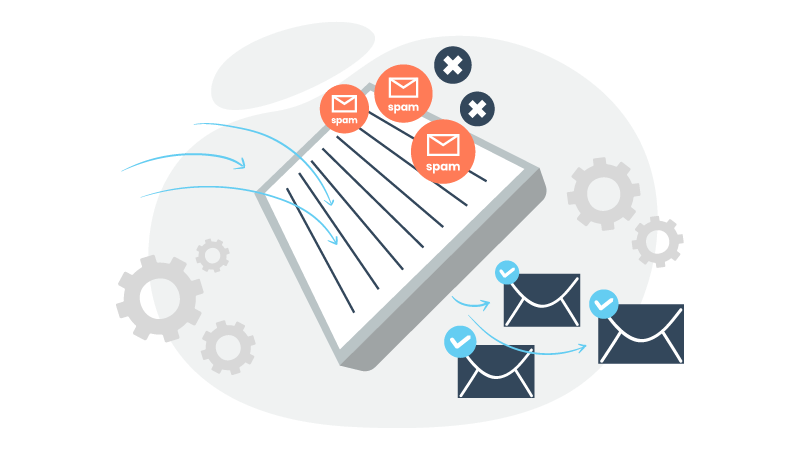Email Ending Up in Spam? The Best Email Deliverability Tools
Effective email marketing is a crucial aspect of any business's success. However, a significant challenge that often plagues marketers is the dreaded spam folder.
When your meticulously crafted emails end up there, you miss out on potential customers and opportunities. Fortunately, these tools can help you improve email deliverability and reach customers.

Why Do Emails End Up in Spam?
Every email marketer's worst nightmare is the notorious spam folder. It's the digital abyss where carefully crafted emails go to die. But why does this happen, and what are the factors behind emails ending up in the spam folder?
-
53.49% of emails sent are classified as spam.
-
The average email deliverability rate is around 80%. This means that out of every 100 emails sent, only about 80 will make it to the recipient's inbox.
-
The top 3 reasons why emails are blocked are:
-
Spam filters (40%)
-
Invalid email addresses (19%)
-
Content violations (18%)
-
1. Poor Sending Practices
One of the primary reasons for email deliverability issues is poor sending practices. If you send a high volume of emails quickly or don't segment your email list properly, Internet Service Providers (ISPs) may flag your messages as spam.
2. Low Engagement
ISPs monitor how recipients engage with your emails. If your emails consistently go unopened or are deleted without being read, it signals that your messages are irrelevant, making them more likely to be filtered as spam.
3. Inaccurate Subscriber Lists
Sending emails to outdated or purchased email lists filled with inactive or unverified addresses is a surefire way to land in the spam folder. ISPs favor senders with clean, opt-in lists.
4. Overuse of Spammy Keywords
Using trigger words like "free," "guarantee," or "urgent" in subject lines or content can trip spam filters. It's crucial to maintain a balance and avoid being overly promotional.
5. Lack of Authentication
Email authentication protocols like SPF, DKIM, and DMARC are essential for verifying your identity as a legitimate sender. Without these, your emails may be treated with suspicion.
6. Blacklisting
If your IP address or domain is listed on email blacklists due to spammy activities, ISPs will readily direct your emails to the spam folder.
7. Hidden Unsubscribe Links
Concealing or making it challenging for recipients to find the unsubscribe link violates email regulations and can lead to your emails being marked as spam. Recipients may even mark your email as spam manually if it's too challenging for them to unsubscribe.
8. Unoptimized HTML and Coding
Poorly formatted emails or coding errors can trigger spam filters. Ensure that your emails are well-designed and mobile-friendly.
9. Attachment and Link Considerations
Sending emails with large attachments or links to malicious websites can increase the chances of being flagged as spam.
The Role of Email Deliverability Tools
In the quest for pristine email deliverability, marketers have a powerful ally in email deliverability tools. These tools ensure your emails navigate the treacherous waters of spam filters and reach their intended recipients' inboxes. Let's explore their role and significance in email marketing.
-
Enhanced inbox placement: The primary mission of email deliverability tools is to optimize your email campaigns for better inbox placement. They work to ensure that your emails are delivered to the right place rather than languishing in the spam folder. This, in turn, boosts your email marketing success by increasing visibility to your target audience.
-
Spam detection and prevention: Deliverability tools have advanced algorithms and databases that identify and mitigate potential spam triggers. They scan your emails for spammy content, links, or attachments and help you make necessary adjustments before hitting 'send.'
-
List management and segmentation: Effective email deliverability tools often include list management and segmentation features. They help you maintain clean, well-segmented email lists, which is critical for ensuring your messages are sent to an engaged and interested audience.
-
Authentication protocols: Many email deliverability tools facilitate the implementation of essential email authentication protocols such as SPF (Sender Policy Framework), DKIM (DomainKeys Identified Mail), and DMARC (Domain-based Message Authentication, Reporting, and Conformance). These protocols enhance your email's legitimacy in the eyes of ISPs.
-
Reporting and analytics: These tools provide valuable insights through reporting and analytics. They track key metrics like open rates, click-through rates, bounce rates, and conversion rates. This data lets you make data-driven decisions and fine-tune your email marketing strategy.
-
A/B testing: Email deliverability tools often come with A/B testing capabilities, enabling you to experiment with different subject lines, content, and send times. This feature helps you optimize your campaigns for better engagement and, consequently, better deliverability.
-
Alerts and notifications: Some tools offer real-time alerts and notifications to inform you of any deliverability issues. This proactive approach allows you to take swift action if your emails face delivery challenges.
-
Adaptability and scalability: The best email deliverability tools are adaptable and scalable. They can evolve with your business's needs, seamlessly accommodating your email marketing efforts' growth.
Popular Email Deliverability Tools
Email deliverability is a critical concern for email marketers, and achieving high inbox placement rates can be challenging. Fortunately, several popular email deliverability tools are designed to address these challenges.
1. HubSpot
HubSpot offers email marketing tools that assist with email content optimization, personalization, and A/B testing. This ensures that your emails are engaging and relevant to your audience. The platform provides detailed analytics and reporting features to track email performance, identify issues, and make data-driven improvements.
HubSpot allows you to segment your email list based on various criteria, helping you send tailored messages to specific audience segments. It offers marketing automation capabilities, streamlining the email marketing process and allowing you to send timely and personalized messages. Additionally, HubSpot integrates seamlessly with other marketing and CRM tools, making managing contacts and tracking customer interactions easy.
Benefits of HubSpot:
-
All-in-one solution: HubSpot is an all-in-one inbound marketing platform, simplifying email marketing management by centralizing various marketing efforts.
-
User-friendly: HubSpot is known for its user-friendly interface and ease of use, making it accessible for beginners and experienced marketers.
-
Strong analytics: HubSpot provides robust analytics, helping you effectively measure and improve email performance.
-
Automation: Automation capabilities save time and allow for more personalized communication with your audience.
-
Tiered pricing: HubSpot offers tiered pricing plans, making it accessible for businesses of various sizes and budgets. Whether a small startup or a large enterprise, you can find a plan that suits your needs and resources.
-
HubSpot Academy: HubSpot provides access to a wealth of educational resources through HubSpot Academy. This includes courses, certifications, and resources on email marketing and inbound strategies, helping users improve their email marketing skills and knowledge.
Application to Email Deliverability
HubSpot's email optimization and list segmentation features help ensure that emails are targeted and relevant, reducing the chances of landing in spam folders. Its analytics and reporting tools also enable you to monitor email deliverability, track open rates, and adjust strategies to maximize inbox placement.
2. SendGrid
SendGrid offers robust email delivery services, including email sending, monitoring, and analytics. It provides an API for seamless integration into your existing applications and platforms. Additionally, SendGrid allows for list management and segmentation, helping you send targeted emails.
You can perform A/B tests to optimize email content and improve deliverability. Plus, SendGrid supports email authentication protocols like DKIM and DMARC to enhance sender reputation.
Benefits of SendGrid:
-
Scalability: SendGrid suits businesses of all sizes, from startups to enterprises.
-
Reliable delivery: This platform is known for its high email delivery rates, ensuring your emails reach the intended recipients.
-
In-depth analysis: The platform provides detailed analytics, allowing you to assess the effectiveness of your email campaigns.
-
Integration: SendGrid seamlessly integrates with various applications, making it versatile for different business needs.
Application to Email Deliverability
SendGrid's email delivery services and compliance features enhance email deliverability by ensuring that emails are sent reliably and that sender authentication is in place, reducing the likelihood of being marked as spam.
3. Mailgun
Mailgun provides a reliable email-sending service with a focus on high deliverability rates. It offers email validation tools to ensure your email list is accurate and up to date. You can perform A/B tests to optimize email content and improve engagement.
Mailgun's analytics tools help you track email performance and adjust your strategies accordingly. The platform integrates with various applications and services for a seamless email marketing experience.
Benefits of Mailgun:
-
Deliverability: Mailgun's primary focus is on deliverability, making it a strong choice for businesses prioritizing inbox placement.
-
Email validation: The email validation feature helps maintain a clean and engaged email list, further improving deliverability.
-
Developer-friendly: Mailgun is developer-friendly, making it suitable for businesses with more technical teams.
Application to Email Deliverability
Mailgun's strong focus on deliverability, email validation, and A/B testing features improve email deliverability by ensuring emails are sent to engaged recipients, and that content is optimized for maximum inbox placement.
4. SendinBlue
SendinBlue offers tools for creating and sending email campaigns. It provides marketing automation capabilities for sending targeted and timely messages. This platform enables you to segment your email list and manage contacts effectively.
SendinBlue includes A/B testing features to optimize email content and offers analytics and reporting to track email performance.
Benefits of SendinBlue
-
Affordability: SendinBlue is known for its competitive pricing, making it a cost-effective choice for businesses.
-
User-friendly: The platform is user-friendly, with a straightforward interface accessible to users of all levels.
-
Automation: Automation features streamline email marketing processes and enhance engagement.
Application to Email Deliverability
SendinBlue provides accessible email marketing tools that can contribute to better email deliverability through list segmentation and A/B testing. While it may not have the same level of focus on deliverability as some other platforms, it offers a cost-effective solution for businesses looking to improve their email marketing efforts.
Each of these popular email deliverability tools offers unique features, advantages, and limitations. The best tool for your business will depend on your specific needs, budget, and technical requirements. By selecting the right tool and utilizing its features effectively, you can significantly increase the chances of your emails reaching the coveted destination: your recipients' inboxes.
Achieve Email Marketing Success with Deliverability Tools
In the world of email marketing, the journey from crafting compelling messages to ensuring their safe arrival in your recipients' inboxes is a path ridden with obstacles. However, by leveraging the power of email deliverability tools, you can navigate this process with confidence.
By following email marketing best practices and embracing the capabilities of these email deliverability tools, you're well on your way to ensuring that your emails consistently land in your recipients' inboxes, propelling your email marketing success to new heights.
This content is also available in:
- Deutsch: E-Mails landen im Spam? Die besten E-Mail-Zustellbarkeits-Tools
- Español: ¿Emails en spam? ¡Mejora entrega con estas herramientas!
- Français: Emails dans les spams ? Outils de délivrabilité
- Italiano: Email spam? Strumenti consegna
- Română: E-mailul ajunge în spam? Cele mai bune instrumente de livrare
- 简体中文: 电子邮件被视为垃圾邮件?最佳电子邮件发送工具








Leave a Comment